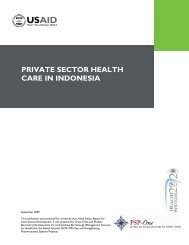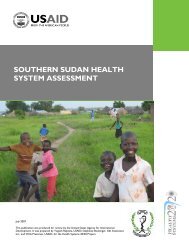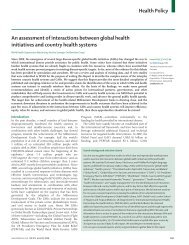Case Study on Piloting Complex Health Reforms in ... - PHRplus
Case Study on Piloting Complex Health Reforms in ... - PHRplus
Case Study on Piloting Complex Health Reforms in ... - PHRplus
You also want an ePaper? Increase the reach of your titles
YUMPU automatically turns print PDFs into web optimized ePapers that Google loves.
Executive Summary<br />
The c<strong>on</strong>cept of pilot<strong>in</strong>g has been effectively used <strong>in</strong> implement<strong>in</strong>g health sector reform<br />
throughout the former Soviet Uni<strong>on</strong>. One of the first pilots <strong>in</strong> Central Asia, established <strong>in</strong> 1994 <strong>in</strong><br />
Issyk-Kul oblast (prov<strong>in</strong>ce or state) <strong>in</strong> Kyrgyzstan, c<strong>on</strong>t<strong>in</strong>ues to provide valuable <strong>in</strong>formati<strong>on</strong> <strong>on</strong> the<br />
process of pilot<strong>in</strong>g complex health reforms. The primary objective of the pilot <strong>in</strong> Issyk-Kul oblast was<br />
to develop or ref<strong>in</strong>e a health system design, specifically to dem<strong>on</strong>strate the feasibility of a mandatory<br />
health <strong>in</strong>surance scheme.<br />
Other objectives <strong>in</strong>cluded dem<strong>on</strong>strat<strong>in</strong>g specific reform designs to provide <strong>in</strong>formati<strong>on</strong> and<br />
evidence to nati<strong>on</strong>al stakeholders over time and to simultaneously build capacity for further<br />
implementati<strong>on</strong>.<br />
This case study describes the pilot process <strong>in</strong> Kyrgyzstan, <strong>in</strong>clud<strong>in</strong>g factors <strong>in</strong>volved <strong>in</strong> the<br />
development of the pilot approach, as well as dimensi<strong>on</strong>s and outcomes of the pilot. The study aims<br />
to:<br />
! C<strong>on</strong>tribute to greater appreciati<strong>on</strong> for the steps <strong>in</strong>volved <strong>in</strong> design<strong>in</strong>g and implement<strong>in</strong>g a<br />
regi<strong>on</strong>al pilot to test complex health reform;<br />
! Describe how a pilot approach can c<strong>on</strong>t<strong>in</strong>uously <strong>in</strong>form nati<strong>on</strong>al policy and decisi<strong>on</strong> mak<strong>in</strong>g;<br />
and<br />
! Determ<strong>in</strong>e the factors that supported implementati<strong>on</strong>, roll-out, and scale-up of pilot<br />
activities.<br />
Despite the absence of a rigorous comprehensive evaluati<strong>on</strong>, the health reform pilot <strong>in</strong> Issyk-Kul<br />
oblast can be c<strong>on</strong>sidered a success. The pilot resulted <strong>in</strong> the reorganizati<strong>on</strong> of the oblast health care<br />
delivery system, and opened the way for improvements <strong>in</strong> efficiency and quality of care. Positive<br />
results obta<strong>in</strong>ed <strong>in</strong> Issyk-Kul oblast led to expansi<strong>on</strong> of the reform model to additi<strong>on</strong>al oblasts,<br />
<strong>in</strong>stituti<strong>on</strong>alizati<strong>on</strong> of health reform at the nati<strong>on</strong>al level, and development of a productive<br />
collaborati<strong>on</strong> am<strong>on</strong>g d<strong>on</strong>ors. Implementati<strong>on</strong> of the model built capacity to implement at oblast and<br />
nati<strong>on</strong>al levels and familiarized stakeholders with the benefits of pilot<strong>in</strong>g.<br />
The pilot project <strong>in</strong> Issyk-Kul and health reform efforts more generally were successful for a<br />
number of reas<strong>on</strong>s. The health reform model was appropriate to the Kyrgyz sett<strong>in</strong>g, the political<br />
c<strong>on</strong>text was c<strong>on</strong>ducive to reform and experimentati<strong>on</strong>, and a c<strong>on</strong>sistent, yet flexible visi<strong>on</strong> was<br />
developed to guide reform efforts. A step-by-step operati<strong>on</strong>al approach and well-def<strong>in</strong>ed processes<br />
(pilots, jo<strong>in</strong>t work<strong>in</strong>g groups) to plan, discuss, problem solve, and evaluate health reform<br />
implementati<strong>on</strong> enabled counterparts to learn by do<strong>in</strong>g, use evidence to <strong>in</strong>form decisi<strong>on</strong>s, and<br />
<strong>in</strong>stituti<strong>on</strong>alize health sector decisi<strong>on</strong> mak<strong>in</strong>g. C<strong>on</strong>sistent and knowledgeable counterparts (turned<br />
health reform champi<strong>on</strong>s) were critically important to success, as were high quality technical<br />
assistance and effective d<strong>on</strong>or collaborati<strong>on</strong>. The <strong>in</strong>itial pilot, subsequent roll-out, and nati<strong>on</strong>al<br />
<strong>in</strong>stituti<strong>on</strong>alizati<strong>on</strong> were made possible through committed local f<strong>in</strong>anc<strong>in</strong>g, health sector sav<strong>in</strong>gs from<br />
Executive Summary<br />
xi

















